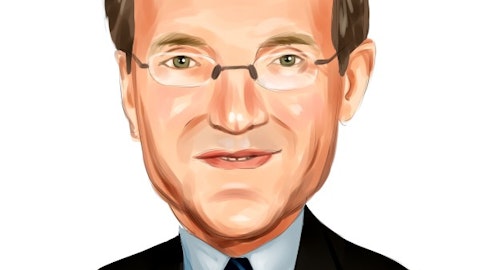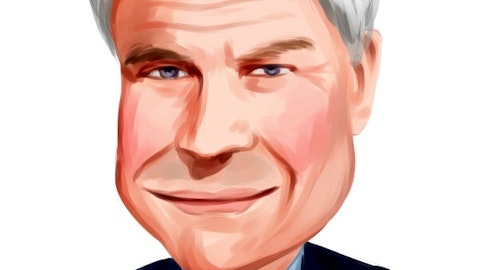Rakesh Sehgal: So, look, we should see cash collections doing the double-digit and then portfolio income is going to continue to grow, but I would say that it’s going to be — on a quarterly basis, you will see it growing year-over-year slightly under the cash collections. Remember that portfolio income is also dependent on our full book and that are lower yielding vintages that we have purchased recently in the 2020 to 2022 timeframe that would continue to impact that portfolio income. But we’re very optimistic here Mark, as we’ve seen the improvement now for the last two quarters as portfolio income has started moving up in the right direction, we expect that to continue going into the next few quarters of 2024.
Mark Hughes: Again, thanks for the detail. Appreciate it.
Vikram Atal: Thank you.
Operator: Your next question comes from the line of John Rowan from Janney. Your line is now open.
John Rowan: Good evening, guys. Just I want to make sure I understand all the guidance correctly. So there’s the number of $1.5 billion of collections, but that’s just under the current ERC. We are guiding for collections to be up double digits, that would imply something north of $1.8 billion, am I correct? I’m just trying to make sure I get the collections then the expense numbers correct to foot up with the cash efficiency ratio guidance. So is a $1.8 billion give or take kind of the baseline figure for our cash collections for the year assuming at least a 10% growth rate?
Rakesh Sehgal: Yes, you are thinking about it correctly, which is the $1.5 billion is just ERC, that does not take into account the new buying, that’s going to happen as well as the cash collections. So I think you’re headed in the right direction that we’re talking about a cash collection number that is north of that $1.5 billion. And so you’re absolutely headed in the right direction.
John Rowan: Okay, but then just to make sure the expense numbers are correct. So you’re saying that there’s a modest growth, or you had $702 million expenses in this year. Now there were a couple of items in there that were nonrecurring or nonoperational in the first and the third quarters. So, are we just expecting growth? I mean, our operating expenses supposed to be north of $702 million for 2024.
Rakesh Sehgal: The way I would approach that is, as Vik said, we are going to continue to invest in the business to grow the business, and there is the expense management program. And so there will be modest growth in expenses, but the way to think about it is we have cash collections growth that is going to be significantly higher than the growth in those expenses.
Vikram Atal: And just to be clear, we don’t have a governor in the business on the dollar amount of expenses, right. We are looking at the business to say we want to optimize and maximize cash collections in an appropriate way. And if that requires additional expense, then we will do that. I think the way that that we will guide your thinking on this is to say that the expense growth rate will be lower than the cash collections rate that we are experiencing.
John Rowan: Okay. That’s helpful. If we’re trying to pin an efficiency ratio, right, obviously, the 57.3% number in the fourth quarter came in kind of well below guidance, which I believe you guys had said was going to be flattish relative to the third quarter. So, just kind of understanding what the actual numbers are as opposed to the efficiency ratio is helpful. Okay, thank you. That’s all for me.
Vikram Atal: Thanks, John.
Operator: Your next question comes from the line of Robert Dodd from Raymond James. Your line is now open.
Robert Dodd: Hi, guys. First a question about purchasing. I mean, Vik, in your prepared remarks you talked about EU [indiscernible] Europe being a little hard to predict, right? Is it getting more so is the question. I mean, even the forward flow agreements in Europe are lower this quarter than they were last quarter, and obviously they are down more than half from where they were this time last year. So has there been any definite change in how your disposal forward flow in Europe? Or is it getting even more spot oriented than it was even, say, a year ago or 6 months ago? Any comments on that?
Rakesh Sehgal: I don’t think so. Robert, I think that behavior of sellers behavior of sellers in Europe has remained the same. We have forward flow arrangements with major institutions across the continent and in the U.K. I think unlike the U.S., we have not seen the same uptick or a similar uptick in losses across the pond. And so there’s no change. I think as we pointed out in our remarks, there were fewer spot transactions that came to market in the fourth quarter. And we — that timing is dependent on when players choose to bring that to market. So, there’s no change in seller behavior. And we are making sure that we are taking a — in building our expectations for 2024 that we do not have expectations that are outside what we are recently experiencing. So we’re being careful not to overestimate what the future buying would be. We want to be like running this business with appropriate based on assumptions.
Robert Dodd: Got it. Thank you. And if I can one more on beating the [indiscernible]. Does the 6% to 8% include any assumptions on forward change in curves or expected changes in curve shapes during the course of 2024? I mean, if you execute, then you said, hey, we’ll follow through in changing expected collections. But Is any of that built into the 6% to 8% target? Or is that excluded?



